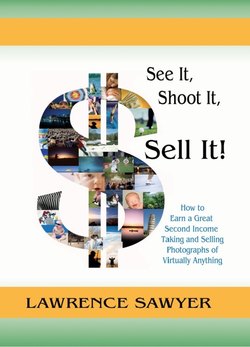Читать книгу See It, Shoot It, Sell It! - Lawrence Sr. Sawyer - Страница 4
Introduction
ОглавлениеThis book is for people with a camera who have wondered if there’s a way to make money with the pictures they take. This book is also for anyone who has an interest in photography, and is looking for a way to pick up a few bucks. Plus, this book is for newcomers to the world of stock photography – folks who may have already taken the plunge and signed up with a microstock agency, but are still pretty new to the game and want to learn more. It’s time to get on the fast track.
I got started in stock photography while pursuing my college degree in the late 1970s and early 1980s. I knew only two things: I loved photography, and I had a strong bent toward business. While I took classes and moved toward my eventual split major in photography and business, I researched the industry and began shooting photographs with the goal of being represented by a major photo agency. It was a long journey – it took eight years to become a good enough photographer to amass a library of images large enough to convince an agency to give me a contract. In the meantime, I shot black and white film, did my own processing and printing, and submitted my work to magazines and local publishers. And they started buying.
All the while, I was reading books to learn everything I could about the stock photography industry. I learned what I needed to know to get started shooting color for my own image library and for submission to an agency. I found that one had to shoot slide film, technically known as transparency film. The burn rate was high.
If one tenth of the frames you exposed came back technically perfect enough to submit to an agency, you were doing well. Slide film and processing were expensive: ten dollars per roll in combined costs for film and processing (and remember those were 1980s dollars). Many photo agencies accepted only 30 to 40 percent (and often less) of the images that were submitted. In terms of sales, those in the industry suggested that you could earn about one dollar per image on file, per year.
Are you doing the math? It cost ten dollars to produce four slides, only one or two of which the agency would accept, thereby netting one to two dollars per image per year. So purely on the basis of raw material costs you could expect to spend at least three years reaching a break-even point, taking in what you were spending. (In the meantime, you have written off thousands of dollars in expenditures as start-up costs.) In this scenario, it would take many years to see any sort of consistent profit, and that was if you were at least average! That’s all I was – just average. I was dedicated, but my photography skills were certainly not developed enough to vault me ahead of the pack.
I lay this out for you, dear reader, to illustrate how difficult it was to break into the business and gain any kind of foothold. As this book is being published in 2010, photography has gone through radical changes, and those changes have made it very easy for the amateur photographer to produce great-looking photographs. Photography today is as much about computers and software as it is about cameras and lenses. You no longer need to know a great deal about the physics of light or chemistry, and that bodes well for you, my friend. Technology has opened a door into the world of selling your photographs and making money passively – including while you sleep!
In the age of the Internet, anyone on the planet with a connection to the web can find your photographs and pay a fee to use them, and those transactions happen 24 hours a day, seven days a week, 365 days a year. You literally make money in your sleep, in perpetuity. Now you can understand why this industry is so appealing!
